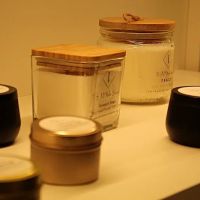How to Avoid Headaches from Scented Candles
- 1. Why Scented Candles Cause Headaches
- 2. How to Choose Scented Candles That Don’t Cause Headaches
- 3. How to Avoid Overwhelming Scents
- 4. Environmental Factors That Affect Scented Candles
- 5. Alternatives to Scented Candles for a Pleasant Atmosphere
- 6. Why Scent Snob Is the Right Choice for Candles
1. Why Scented Candles Cause Headaches
Scented candles have long been a staple in homes, offering a cozy and fragrant atmosphere. However, many individuals experience headaches or other discomforts when burning certain scented candles. This phenomenon is common but often misunderstood. There are several reasons why scented candles can trigger headaches, and understanding them can help you make better choices when it comes to purchasing and using them.
One primary reason scented candles cause headaches is the presence of synthetic fragrances. Many candles on the market contain artificial chemicals that can be irritating to the respiratory system and the nervous system. When inhaled, these chemicals can cause a variety of symptoms, including headaches, dizziness, and sinus congestion. Some individuals may be more sensitive to these chemicals than others, which can lead to more frequent headaches. The use of paraffin wax, a common ingredient in many candles, can also release harmful fumes when burned, which can exacerbate the issue.
Another factor is the concentration of fragrance oils. Highly fragrant candles can release potent scents into the air, overwhelming your senses. This intense concentration can trigger headaches, especially for individuals who are sensitive to strong smells. The size of the room, the ventilation, and the length of time the candle is burned can also influence how strongly the scent is distributed, increasing the chances of a headache.
2. How to Choose Scented Candles That Don’t Cause Headaches
When selecting scented candles, there are several factors to consider in order to avoid the discomfort of headaches. The type of wax, the ingredients in the fragrance, and the strength of the scent all play a role in how the candle affects your health.
One of the first things to look for is candles made from natural waxes, such as soy, beeswax, or coconut wax. These types of waxes burn cleaner than paraffin wax, which can release harmful chemicals into the air. Natural waxes also tend to distribute fragrance more gently, reducing the likelihood of an overpowering scent that might trigger a headache.
It’s also important to consider the quality of the fragrance used in the candle. Opt for candles that use essential oils or natural plant-based fragrances rather than synthetic ones. Essential oils are derived from plants and are generally less irritating to the respiratory system. Be sure to check the label for information about the fragrance ingredients to ensure they are natural and non-toxic. For those who are particularly sensitive to scents, choosing unscented candles or those with very subtle aromas can help avoid headaches.
Finally, pay attention to the size and burn time of the candle. Candles that are too large for the space or burned for extended periods can fill the air with overwhelming scents, leading to headaches. It’s a good idea to opt for smaller candles or use larger candles in well-ventilated areas to ensure the scent does not become too concentrated.
id="how-to-avoid-overwhelming-scents">3. How to Avoid Overwhelming Scents
Even if you’ve chosen a high-quality, natural candle, there are still ways to ensure that the scent doesn’t become overwhelming. Here are some tips to help you control the intensity of the fragrance and avoid headaches:
- Burn Candles in Well-Ventilated Areas: Proper ventilation helps prevent the concentration of scent in a small area, which can lead to headaches. Open windows or use a fan to disperse the fragrance and keep the air fresh.
- Limit the Amount of Time You Burn Candles: Burning candles for extended periods of time can lead to an accumulation of scent in the air. To avoid this, try to limit your candle-burning sessions to 1-2 hours at a time, allowing the air to clear before relighting the candle.
- Choose Mild Scents: Opt for lighter fragrances, such as lavender, vanilla, or citrus, which are less likely to overwhelm your senses. Strong floral or musky scents tend to be more potent and can trigger headaches more easily.
- Use Candle Warmers: If you enjoy the ambiance of a scented candle but want to avoid direct exposure to the smoke or flames, consider using a candle warmer. This method gently releases the fragrance without the potential side effects of burning.
By following these tips, you can create a pleasant atmosphere with your scented candles without triggering headaches or other discomforts.
4. Environmental Factors That Affect Scented Candles
Environmental factors play a significant role in how a scented candle burns and how the scent is distributed in your space. Understanding these factors can help you manage your candle-burning experience and avoid headaches.
The size of the room is one of the most important considerations. A small room with poor ventilation will trap the scent, making it more concentrated and potentially overwhelming. On the other hand, a large, open room with good airflow will allow the scent to dissipate more evenly, reducing the chances of it becoming overpowering. Adjusting the placement of your candle can help with scent distribution—avoid placing candles in corners or near vents where the scent may concentrate too much.
Humidity levels also affect how a candle burns. High humidity can prevent the candle from burning evenly, leading to a stronger scent concentration and an increased risk of headaches. To ensure a smooth, even burn, keep your candles in environments with moderate humidity and temperature.
5. Alternatives to Scented Candles for a Pleasant Atmosphere
If you’re prone to headaches from scented candles or simply want to try something different, there are several alternatives that can help you create a pleasant ambiance without relying on candles.
- Essential Oil Diffusers: These devices use water and essential oils to create a mist of fragrance. They are often gentler than scented candles and offer more control over the intensity of the fragrance.
- Herbal Sachets: Filled with dried herbs like lavender, chamomile, or rosemary, sachets can provide a natural scent without the risk of overpowering fragrances. Place them in drawers, closets, or on a shelf for a subtle aroma.
- Air Purifiers: Some air purifiers have built-in scent diffusers, allowing you to add essential oils while purifying the air. This is a great way to maintain clean, fresh air in your home without the risk of headaches from traditional candles.
These alternatives can provide a calming atmosphere while being gentler on your senses. They’re perfect for anyone looking to enjoy pleasant fragrances without the potential side effects of scented candles.
6. Why Scent Snob Is the Right Choice for Candles
If you’re looking for high-quality candles that are designed to provide a pleasant, headache-free experience, Scent Snob offers a wide selection of natural, carefully crafted candles that prioritize your comfort. Their candles are made with essential oils and natural waxes, ensuring a clean burn that is less likely to trigger headaches.
With a variety of scents to choose from and options for every room in your home, Scent Snob makes it easy to enjoy a beautiful fragrance without the fear of discomfort. Whether you’re looking for a light lavender scent to relax or a fresh citrus aroma to energize, Scent Snob’s candles provide a safe, natural alternative to synthetic candles.
Ready to explore a new world of candles that enhance your environment without causing headaches? Visit Scent Snob today and find the perfect candle for your home!



0 comments